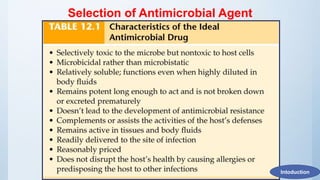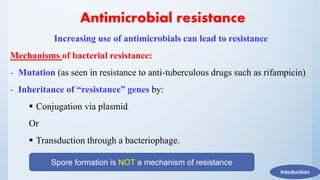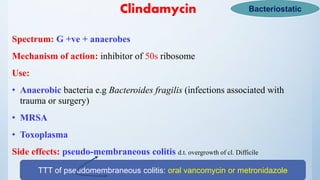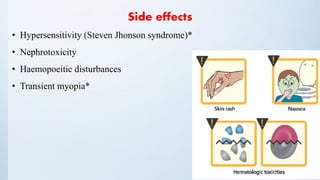This document discusses various classes of antibiotics including their definitions, mechanisms of action, spectra of activity, and examples. It covers cell wall synthesis inhibitors like penicillins, cephalosporins, vancomycin, and carbapenems. It also discusses protein synthesis inhibitors including aminoglycosides, tetracyclines, macrolides, chloramphenicol, and clindamycin. Each class is described in terms of its mechanism, examples, indications, and side effects. The document provides a comprehensive overview of different antibiotic classes.
























![Penicillin
ExamplesGroup
* Benzylpenicillin (Acid sensitive = NOT oral)
* Phenoxymethylpenicillin
(Acid resistant = Given oral)
Narrow spectrum – penicillinase
(= β-lactamase) sensitive
* Methicillin:
[ Poor oral availability (only parenteral)]
* Oxacillin: Good oral availability
* Cloxacillin
* Dicloxacillin
Narrow spectrum – penicillinase
(= β-lactamase) resistant
* Ampicillin (Oral)
* Amoxicillin (Oral)
Broad spectrum – penicillinase (=
β-lactamase) sensitive
(= Aminopenicillins)
* Carbenicillin: [Poor oral availability]
Active against gram +ve & gram –ve bacteria
Active against Pseudomonas aeruginosa, Klebsiella
* Ticarcillin
* Mezlocillin
* Pipercillin
Extended spectrum – penicillinase
(= β-lactamase) sensitive
(= Carboxypenicillins)
×× Cell wall](https://image.slidesharecdn.com/antibiotic-160322042856/85/Antibiotic-25-320.jpg)

![Cephalosporin
• Semi-synthetic antibiotics [derived from fungus Cephalosporium ]
• Contain β lactam ring
• Mechanism of action: ……………
Susceptible to β lactamase that is present in some bacteria e.g. Staph
Cidal
Cross-allergies with penicillins are common
×× Cell wall](https://image.slidesharecdn.com/antibiotic-160322042856/85/Antibiotic-27-320.jpg)














![1. AmiNOglycosides
• NO protein synthesis [ by inhibition of 30s ribosome]
• NO pregnancy [Teratogenic]
• Negative Organisms killer
• NOt active against anaerobes
• Nephrotoxic - Ototoxic
Scheme](https://image.slidesharecdn.com/antibiotic-160322042856/85/Antibiotic-42-320.jpg)
![1. Aminoglycosides
Spectrum: effective against gram -ve aerobic bacteria
[Gentamycin & tobramycin kill staph. ]
Distribution: (water soluble = very polar)
Poor penetration to BBB / Cornea
[ Good penetration if inflamed tissue e.g. meningitis]
= NOT used orally but parenteral [may be used in endopthalmitis]
= Used topically for external eye infections e.g. conjunctivitis - keratitis
bactericidal
Penetration into cell requires an oxygen-dependent transport
So, anaerobes are resistant](https://image.slidesharecdn.com/antibiotic-160322042856/85/Antibiotic-43-320.jpg)



![Neomycin
One of the most toxic aminoglycosides
• Routes:
o Oral: poor penetration [ Used locally in GIT]
e.g. preparation of bowel before surgery or hepatic encephalopathy
o Topical: skin & external ear
o I.V.: rarely used
• Side effect : Allergy is very common + …………
Neomycin is used in ophthalmology for acanthameoba](https://image.slidesharecdn.com/antibiotic-160322042856/85/Antibiotic-47-320.jpg)
![Tetracycline
Having a nucleus of four cyclic rings
Spectrum:
• G +ve / G –ve
+
• Rickettsia [ Typhus – Q fever ]
• Chalmydia
• Mycoplasma pneumoniae
• Mechanism of action :
Inhibit protein synthesis: by binding to 30s ribosomes
Prevent attachment of aminoacyl-t-RNA to the mRNA ribosome complex.
Bacteriostatic](https://image.slidesharecdn.com/antibiotic-160322042856/85/Antibiotic-48-320.jpg)

![Tetracycline: Ophthalmological uses
• Anti-collagenase action
TTT of sterile (non-infected) corneal ulcer [corneal melting]
in which stromal necrosis is thought to be d.t. collagenase activity
• Topically for trachoma
But systemic erythromycin is the drug of choice !](https://image.slidesharecdn.com/antibiotic-160322042856/85/Antibiotic-50-320.jpg)

![Side effects
Change in dentation: discoloration & dysgenesis [ contraindicated before 8 years ]
d.t. formation of tetracyclin – calcium phosphate complex](https://image.slidesharecdn.com/antibiotic-160322042856/85/Antibiotic-52-320.jpg)
![Macrolides
Mechanism of action : Macrolides bind to 50s ribosome and interfere with translocation
Taken on empty stomach
Specterum
Mostly G +ve and a few G-ve bacteria e.g. Hemophilus,
+ atypical bacteria (Legionella, Chlamydia, Mycoplasma)
[Narrow spectrum antibiotics similar to penicillin]
[Good alternative for patients with penicillin allergy]
bacteriostatic
Poor penetration to BBB & BAB
Erythromycin is bacteriocidal in high dose](https://image.slidesharecdn.com/antibiotic-160322042856/85/Antibiotic-53-320.jpg)
![Macrolides
Erythromycin is highly active against:
• Str. Pyogenes
• Str. Pneumaniae
• N. gonorrhoeae
• C. diphtheriae
Azithromycin [Very long half-life (>24 h)]
Clarithromycin
• Used for H. pylori infection](https://image.slidesharecdn.com/antibiotic-160322042856/85/Antibiotic-54-320.jpg)



![Side effects
[Dose dependent]
These side effects are for topical & systemic !!!
Restricted for life-threatening infections where no alternative exists
such as Haemophilus influenzae meningitis or typhoid fever
• Bone marrow depression (Reversible)
• Aplastic anemia [idiosyncrasy] (irreversible) (very rare)
• Grey baby syndrome
NOT used at pregnancy & lactation](https://image.slidesharecdn.com/antibiotic-160322042856/85/Antibiotic-58-320.jpg)




![Quinolones
Mechanism of action:
Inhibitors of DNA Gyrase (= Topoisomerase II) [a bacterial enzyme that winds and unwinds
DNA (required for supercoiling the bacterial genome)] inhibition of DNA synthesis and
transcription
Bacteriocidal](https://image.slidesharecdn.com/antibiotic-160322042856/85/Antibiotic-63-320.jpg)





![Metronidazole
Spectrum
• Anaerobes (e.g. bacteroides)
• Protozoa:
Amoeba (drug of choice)
Trichomonas vaginalis (drug of choice)
Giardia (drug of choice)
Mechanism of action:
Inhibition of microbial DNA synthesis [by forming toxic metabolites]
USE in ophthalmology: Orbital cellulitis in combination with cefuroxime.
Good penetration (Can pass BBB)](https://image.slidesharecdn.com/antibiotic-160322042856/85/Antibiotic-69-320.jpg)












